Partner Content
 Since the founding of the World Wide Web, the amount of time people spend engaging on digital channels has grown at a breathtaking rate. And ON24 has been present for almost the entire journey since its founding in 1998. But the events of 2020 led to a sudden explosion of digital engagement.
Since the founding of the World Wide Web, the amount of time people spend engaging on digital channels has grown at a breathtaking rate. And ON24 has been present for almost the entire journey since its founding in 1998. But the events of 2020 led to a sudden explosion of digital engagement.
Today, the number of ways B2B professionals can engage online is larger than ever.
Audiences are spoiled for choice. And, having seen the experiences they can get as
consumers, from Amazon for shopping to Netflix for film, meeting their expectations can be harder than ever.
So where does this leave the webinar? Is this channel still attracting and engaging audiences more than two decades after its invention?
The answer from our latest Webinar Benchmarks report is an unequivocal “yes.”
Even with all the different channels and experiences available, organizations dramatically increased the number of webinars produced. 2020 saw the number of webinars delivered on the ON24 Digital Experience Platform grow by an astonishing 162%. More than one-quarter of a million ON24 webinars hit the web. And of those, more than 100,000 virtual events had more than 100 participants.
More impressive is the growth in the number of people engaging with webinars. Attendees shot up by 251% to reach more than 60 million. The hours of webinar content consumed grew by 290%, with 61 million hours of content being binged in 2020.
These figures show that webinars offer something special. When given the choice, audiences will choose conversation and two-way interaction over passive experiences. They will choose to access content on their own terms. They will choose experiences that are worthwhile. And they will choose experiences that get better and more personalized over time.
Webinars allow you to do all of this and to surface the signals to make every experience you offer even better than the last.
So, how are you performing when it comes to webinars? By analyzing thousands of webinars with millions of attendees, this annual Webinar Benchmarks report aims to provide a foundation for what “good” looks like. Come on in and find out how your peers are doing — and how you can create even better experiences in 2021.
Methodology
ON24, the world’s leading webinar platform, compiled the data in this report. The events
included in this analysis were selected from a random number of ON24 webinars conducted in the European, Middle East and Africa regions in 2020.
- ON24 measured 17,624 webinars in
this analysis - All webinars were held between January
and December of 2020 - All webinars had at least 100 attendees
Events represent a cross-section of more
than 1,000 accounts - Companies range in size from Enterprise to SMB
To complement the analysis, around 100 ON24 customers from across the world were surveyed to add further insight to data emerging from the platform. In addition, key findings from ON24’s Experiences Everywhere report have been incorporated, based on a wider survey of professionals that includes those not using ON24.
This study examines statistics across a webinar’s lifecycle, including webinar promotion and registration metrics, interactivity metrics, audience viewing habits, and both live and always-on attendance and conversion metrics. Unless otherwise noted, this study uses the following definitions:
- Live webinars — Audio or video-based
events streamed on a specific day and time. - On-demand webinars — Audio or
video-based events attendees can view
always-on, including archived live webcasts. - Registrants — Prospects registered to view
an event. - Attendees — Prospects who registered to
view an event and attended that event.
Webinar Success
Webinar Volume
59% of survey respondents plan to
increase the number of webinars
they produce in 2021.
Webinars lend themselves to all kinds of communication activity. At ON24, we see three
use cases that come up the most frequent: marketing, training and continuing education. Many organizations carry out all three.
The number of webinars a company delivers per year varies according to its audience, resources and business goals. There is no right answer — it’s the quality of the content, not the number of webinars you produce, that determines whether your webinar
program is successful.
Around one-third (34%) of surveyed ON24 customers ran between 50 and 150 webinars
2020, with less than half (46%) running up to 50. Of the respondents, about six in ten (59%) say they plan to increase the number of webinars they produce in 2021.
Serialized webinar programs with an established host and format is one method producers can use to increase webinar volume while reducing the time
required to set up an event. Around half (51%) of those surveyed take such an approach, with a further 11% planning to do so.
Average Number of Webinars in 2020
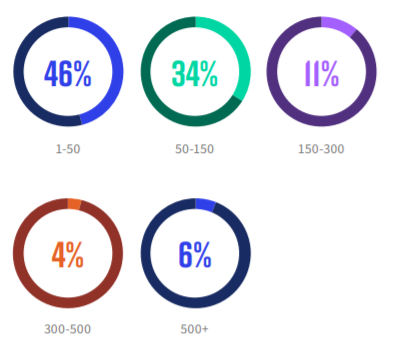
ON24 Tip: Produce a regular stream of webinar content.
Don’t fall into the trap of seeing webinars as just a tactic to add on to the end of your marketing campaigns or education
and training efforts. Instead, make them a regular and frequent part of your marketing activity. As you run more sessions,
you’ll find out what works for your audience — allowing you to continuously improve performance.
Pre-webinar Benchmarks
Promotional cycle
1% of registrants sign up to a webinar
on the day it is broadcast.
Webinars help to build audiences and scale. The content of your webinar is a key element, but so is the way it’s promoted. Getting people to be aware, if not excited, about webinars, should be a concerted effort that starts at least two weeks before launch, or even earlier.
The majority (53%) of webinar registrants in EMEA sign up either during the seven-day
period before the event takes place or the day of the event itself. Conversely, early registrants, those who enroll at least 15 days before the event, account for 26% of our sample — a nine-point drop from 2020.
This rapid flip from long-tail to short-tail sign ups may be attributed to the massive increase in the number of virtual events held in 2020
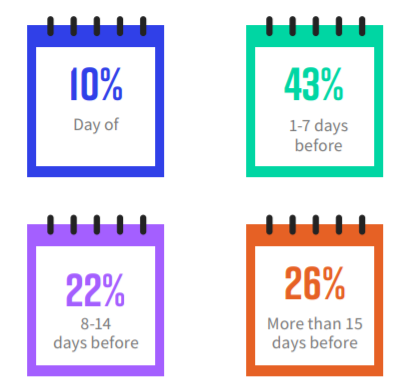
ON24 Tip: Longer promotional campaigns translate to more registrants.
Pursuing a longer promotion cycle can boost registration rates and increase the likelihood of converting registrants into attendees. Promotional emails shouldn’t just be reminders though. Hit the ground running by including supporting content and building up excitement ahead of your webinar. Read more in our Webinar Registration Best Practices Guide
Best Days to Send Promotional Emails
64% of those delivering webinars for account-based marketing do so
directly through email.
Email is the most effective channel for promoting webinars and driving registrants, so it’s an area that requires careful consideration. As shown in previous benchmark reports, mid-week promotional emails perform best. Tuesday, Wednesday and Thursday are the strongest performers, accounting for around two-thirds (63%) of registrations.
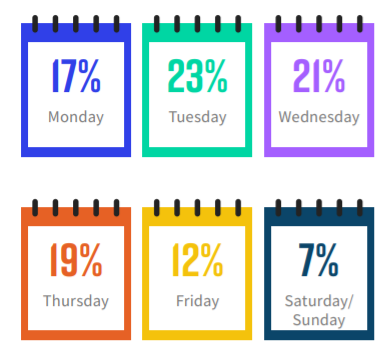
Best Days for webinar attendance
49% of ON24 customers say they have a designated host (or hosts) for their webinars.
Mid-week is also the best time to hold a webinar, with Wednesday and Thursday again emerging
as strong performers. However, the best day for a webinar entirely depends on your webinar goals and your audience.
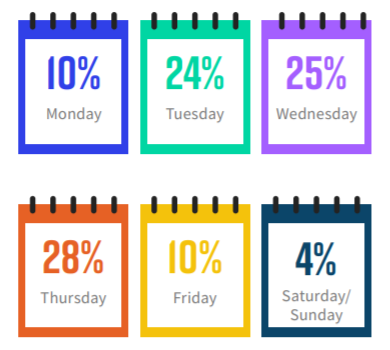
Best time to run webinars
24% of ON24 webinars are broadcast between 10 a.m. and 12 p.m. PT
The best time to run a webinar is 10 a.m. GMT. Other times to consider are 2 p.m. and 3 p.m. Remember, the optimal time to run webinars depends on where your audience resides so don’t be afraid to experiment.
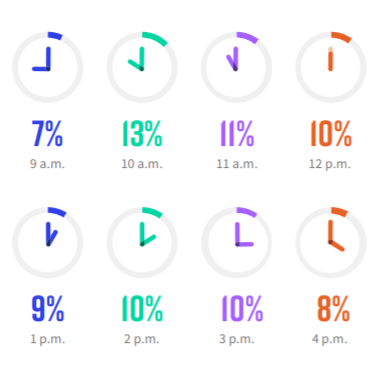
ON24 Tip: Run your webinars around the middle of the day.
The best time for a webinar is one fitting in with your audience’s schedules, but as a rule, lunchtime to early afternoon works well. If in doubt and covering multiple time zones, consider where your primary market is and shoot the hours before and after lunch.
Branding Your Webinars
Today’s audiences expect a consistent brand experience across all the touchpoints. So it’s good
to see that some 95% of ON24 customers report that their webinars look like their brand.
While ON24’s tools allow for any user to customize the look and feel of their digital experiences, many are going the extra mile. Almost half (49%) say had a designer to help to brand their webinars.
ON24 Tip: Customize your webinar console to drive engagement.
Take advantage of the webinar environment to build a connection between the attendee and your brand. A fully branded, customized webinar console helps you set your program apart from the get-go. Read our Webinar Console Branding Guide to learn how you can get started. When you’re ready for the next level, check out our guide to creating experiential events.
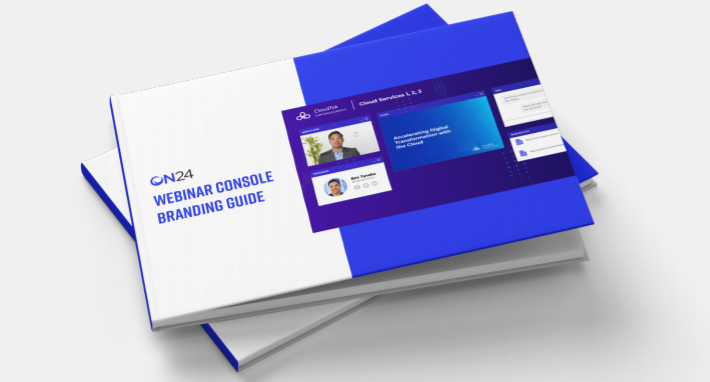
Live webinar Benchmarks
Average viewing time
61M hours of webinar content was watched through ON24 in 2020.
The optimal webinar length depends on the topic, content, audience and program’s goals. The majority of webinars on the ON24 Platform last for around an hour but can easily exceed that if they cover a particularly complex issue.
In 2020, the average viewing time for webinars in EMEA was 59 minutes.
This slight upward trend could be explained by the decrease in viewers using smartphones to attend webinars. In the last quarter of 2020, some 13% of EMEA attendees tuned in on a mobile device, up 1% for the same period in 2019.
Average viewing time for webinar attendees:
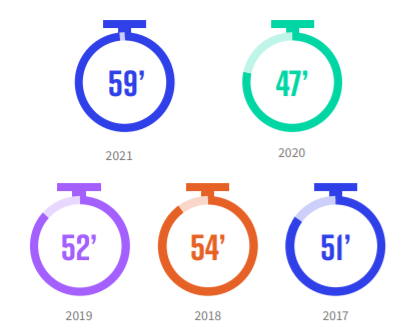
Registrant to Attendee Conversion
53% of EMEA registrants convert to 53% attendees on average.
Getting registrants is the first step in a successful webinar program, but the attendance rate is one of the key performance indicators you need to look at to gauge an event’s efficacy. Usually, a conversion rate between 35% and 45% is considered good.
In 2020, the average registrant to attendee conversion rate in EMEA overall was 53%. For
events with more than 100 attendees, the average conversion rate was 43%. According to our data,
communications and continuing education see the highest conversion rates in EMEA (79% and 64%, respectively).
Average webinar conversion rate for webinars with more than 100 attendees:
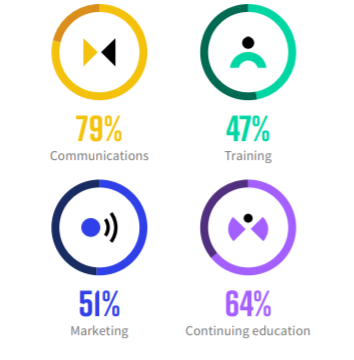
Average Attendee Rate
66% of global webinars in 2020 featured some type of video.
According to our data, 41% of ON24 EMEA webinars in 2020 attracted at least 100 attendees — up from 32% in 2019. Of these webinars with at least 100 attendees, the attendance rate for webinars with 300 or more attendees in EMEA is holding steady at 26%.
Distribution of webinar by size, as a percentage of webinars with more than 100 live attendees:
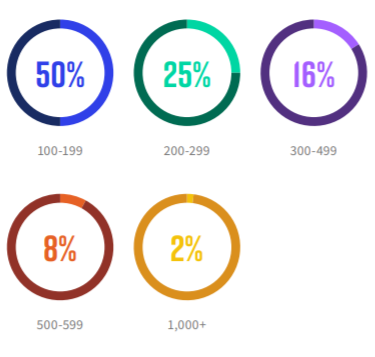
ON24 Tip: Use webinars to broadcast your in-person events for maximum reach.
Reach a larger audience and create a more tailored experience by combining the impact of in-person events with the scale provided by webinars. Whether it is a hybrid event or a fully virtual conference, you can meet the needs of different personas and provide always-on content they can access on their terms. Check out our webinar on How Box Uses Digital to Boost the Impact of In-Person Events.
Integration of Engagement Tools
70% of all webinars in 2020 offered resources for attendees to download or engage with.
Two-way engagement is one of the key benefits of webinars, so encouraging engagement throughout each session is essential.
Overall, respondents rate the interactivity of their webinars as 3.2 on a five-point scale, up from 3.0
in 2019.
As was the case last year, the Q&A tool is the most popular engagement choice to drive audience interaction in EMEA, used in 84% of all analyzed webinars.
Resource lists (65%) and surveys (45%) are the next most frequently used engagement tools. Compared to last year’s report, the use of surveys has increased
by two percentage points.
However, driving engagement requires more than just presenting engagement tools within a webinar console or other digital experience. The skills of the host make a significant difference, which may explain the fact that half (49%) of ON24 customers have at least one designated webinar host for their webinar programs.
Respondents are also looking to up their engagement game. When asked to choose their number one priority for 2021, 42% stated that they would look to deliver more engaging and interactive webinars — a figure more than double that of the second most common priority, which was in improving registration for live events (20%).

ON24 Tip: Measure your marketing webinars beyond numbers of leads.
Define what engagement means for your organization, as this will help you identify the goals you need to measure progress against over time. Always keep track of conversion rates but don’t forget about looking at drop-off points and attendee feedback. Download the B2B Marketer’s Guide to Optimization to find out more.
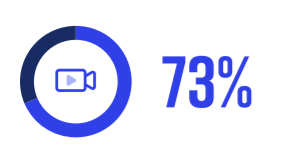
Roughly 73% of all live EMEA webinars in 2020 featured some type of video — 26-points higher
than in 2019.
This suggests practitioners are becoming increasingly comfortable with the use of video technologies and are acknowledging the importance of incorporating video into webinars. Providing further proof is that 85% of ON24 customers state that their presenters are on video more frequently since the outbreak of the COVID-19 pandemic.
35% of ON24 customers have bought new equipment for their webinar programs.
For ON24 webinars, videos include:
• Studio produced
• Webcam presentations
• Integrated video clips
• Streaming and screen sharing
While using video on a webinar requires little more than a webcam and computer, a good number of ON24 customers have been making investments in hardware that helps lift the quality of their video experience. Some 35% of those surveyed said they bought new equipment for their webinar program in the past year or before.
ON24 Tip: Use video in your webinars to drive engagement.
Video is one of the most effective forms of content you can use to convey your message, and adding video to webinars has been proven to increase audience engagement and viewing times. Turn passive viewing into active engagement by integrating relevant video content into your webinars. For more tips, read our guide on Five Ways to Integrate Video Into Your Webinars.
Personalizing Webinar Experiences
29% of ON24 customers integrate their webinars into personalized landing pages for target audiences.
Personalized experiences are critical to a modern marketer’s success. With webinars, organizations can add a higher level of personal engagement, whether for specific accounts, industries, use cases or general account-based marketing activity.
Our survey of ON24 customers shows a healthy proportion are taking action to make their webinars more relevant to their target customers, About half of respondents (49%) use webinars as part of their account-based marketing efforts. Of this group, the most common method of delivery for these webinars is through email, with 64% doing so.
Aside from account-based marketing, some 46% create webinars aimed at specific industries, while 14% do so by use case.
Furthermore, webinars do not have to be personalized in a standalone fashion. Around three
in 10 (29%) integrate webinars into personalized landing pages for target audiences, with a further 15% planning to do so. Such an approach can repurpose otherwise generic webinars into a
highly-targeted offering.
ON24 Tip: Repurpose your webinars for account-based marketing.
The effort you invest in your webinars can continue to drive results long after the event is over. One way to repurpose your webinars is to embed them in a page that is specifically designed to engage the target account, which can include both the brand of your target account, downloadable content, contact us buttons and even the contact details of your customer success team. To find out more, check out ON24 Target.
Post-webinar Benchmarks
On-demand viewing
57% of ON24 customers create webinars that go straight to on-demand viewing
While live broadcasts remain the main type of webinar delivery because they encourage real-time
engagement, on-demand webinars have increased in popularity as registrants can access them when it’s most convenient for them. Doing a live webinar and then making the recording available on-demand can offer you the best of both worlds.
Attendee data shows an increasing preference towards watching live webinars. Of actual webinar
attendees, live-only attendance saw a eight-point jump in 2020 while on-demand consumption has
fallen by nine points. However, the combination of attending both live and on-demand versions of
webinars has increased by one percent.
ON24 customers appear to be responding to growing on-demand viewing, as 57% create webinars that go straight to an on-demand session. A further 13% are planning this for the year ahead.
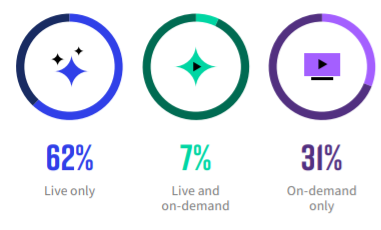
On-Demand Viewing Time
27% of ON24 customers use Netflix-style content hubs to promote their on-demand webinars.
On-demand webinars give your content long term viability. With always on, evergreen webinars you
can continue to engage, educate and accommodate audiences you normally wouldn’t be able to live.
So, what’s a good on-demand viewing benchmark? In 2020, the on-demand viewing time in EMEA
averaged 31 minutes a ten-point increase.
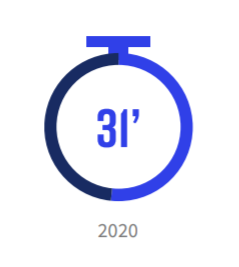
Post-live Registrations
89% of ON24 customers believe that webinars outperform other channels in creating qualified leads.
EMEA attendees prefer live webinar content to on-demand events. In 2020, for example, 31% of all
EMEA attendees only watch on-demand webinars, a nine-point decrease from 2019. Of these on-demand attendees, the majority register a week after a live event.
This change in preference can again be contributed to the volume of webinars produced in 2020 in
response to the COVID-19 pandemic. Still, there is demand for on-demand viewing options. Those
creating and promoting webinars should consider placing webinars and other content within a content hub. Indeed, more than one-quarter (27%) of ON24 customers take such an approach, using Netflix-style content hubs to promote on-demand viewing.
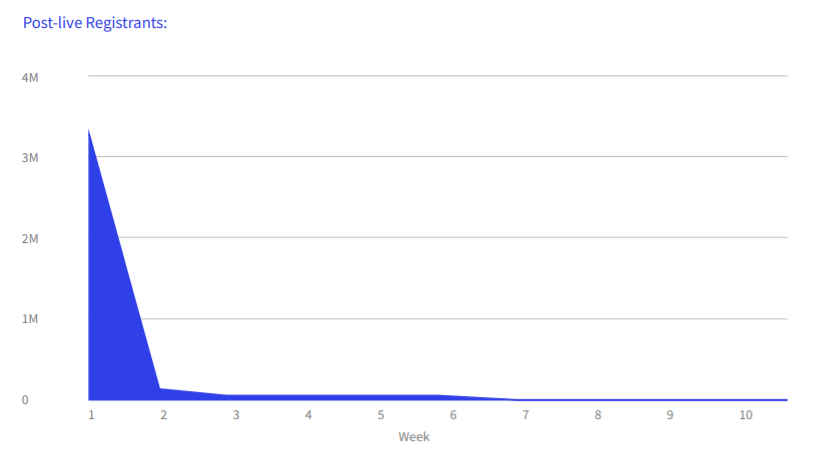
Post-Webinar Data
Use of Post-Webinar Data
72% say that webinars directly impact pipeline and revenue.
Webinars help drive engagement and increase pipeline. As our survey of ON24 customers shows,
the vast majority of respondents (99%) agree that webinars represent a critical element of their 2021 marketing plan. At a strategic level, three in ten (31%) consider webinars to be ‘critical’ while
on average, respondents rate the importance of webinars to their digital marketing strategy as 4.1 on a five-point scale.
When it comes to the impact on the bottom line, the same survey results point to the fact that
webinars do have a direct impact on both pipeline and revenue, with seven in ten (72%) respondents saying as such. Some nine in ten (89%) also believe that webinars outperform other channels in creating qualified leads.
Many also report a positive impact on their marketing spend, as three-quarters (76%) agreed that webinars help to lower their cost-per-lead.
Some 48% of these respondents also consider the quality of leads generated through webinars
to be above average (4 or 5 on a five-point scale), representing a 10-point rise since the last annual
benchmarks report. Overall, respondents rate the quality of leads generated through webinars as 3.5 on a five-point scale (up from 3.3 previously).
Marketers are also using webinars across all funnel stages. Nearly two-thirds (63%) use them for
mid-funnel activities, but webinars are also used for top-of-funnel (58%) and bottom-of-funnel (43%) efforts. Indeed, about half say they are using (38%) or plan to use (12%) webinars to drive key conversions such as demos, trials and appointment setting.
ON24 Tip: Use webinar data to close the loop and improve performance.
Make sure to collect and use data from your webinars to find out what works well and what doesn’t. Also look to integrate your webinar platform with your CRM, marketing automation or e-learning systems — this will help those not directly involved with webinars to be able to see how each one of your customers interacts and engages. Find out how ON24 Connect can help you with this
CONCLUSION
The data from our report shows that 2020 was yet another excellent year for webinars. The EMEA region now watches more than 19,317 hours of webinar content every day. And every four seconds, an EMEA registrant becomes an ON24 webinar attendee.
Over the past few years, we’ve seen not only an increase in webinar volume but also great webinar experiences. There’s been a significant increase in the use of video, on-demand viewing is up, and technology is providing even more ways to engage with audiences. More than two-thirds of ON24 customers (67%) also use webinars to power virtual event experiences.
Our survey data also shows that in a post-COVID world, many ON24 customers anticipate that the changes they made in 2020 will stick. Only 13% say that the future of their physical event strategy will go back to a standalone approach, while 81% will adopt hybrid strategies. Separately, when asked more broadly about their expectations, 34% will reduce their physical marketing efforts while 11% are going all-in on digital channels.
But we also see that there is work to be done to convince others about the benefits of webinars and digital experiences. According to our survey of ON24 customers, 37% say that the most difficult challenge when promoting webinars internally is showing their value, with 31% citing revenue impact. This means there is more work to be done to show how webinars and other digital experiences help to achieve business goals. As Webinerds, we need to make the case that webinars are the ideal channel for reaching our audiences and engaging them in real human ways.
In a noisy world, webinars are how we deliver human engagement at digital scale.
